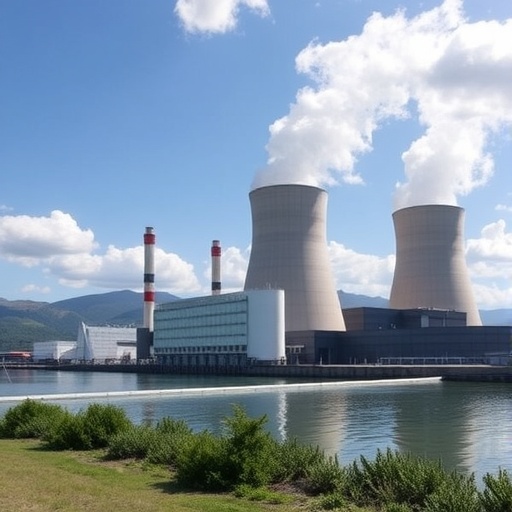Addressing the tritium supply challenge, physicist Terence Tarnowsky and his team at Los Alamos National Laboratory have proposed an innovative approach: repurposing highly radioactive nuclear waste from conventional fission reactors to produce valuable tritium using an accelerator-driven system (ADS). This concept employs particle accelerators to induce controlled fission reactions within spent nuclear fuel, stimulating neutron emissions that, through a cascade of nuclear transformations, generate tritium. Importantly, this system operates sub-critically—unlike traditional nuclear reactors—which means it cannot sustain a chain reaction on its own, significantly enhancing operational safety and control.
.adsslot_OmK9zxWlTh{ width:728px !important; height:90px !important; }
@media (max-width:1199px) { .adsslot_OmK9zxWlTh{ width:468px !important; height:60px !important; } }
@media (max-width:767px) { .adsslot_OmK9zxWlTh{ width:320px !important; height:50px !important; } }
ADVERTISEMENT
The ADS methodology involves sophisticated computer simulations to optimize reactor design, focusing on efficiency and safety. Notably, the team is exploring molten lithium salt as a coolant and medium surrounding the nuclear waste, a strategy adapted from prior experiments with uranium-fueled reactors. Molten salt’s high heat capacity and chemically stable nature present several advantages: it improves thermal management, provides an inherent safety buffer against overheating, and complicates unauthorized extraction of fissile materials, thus mitigating proliferation risks. This multifaceted approach could transform the way nuclear waste is managed, turning a long-term disposal problem into a valuable resource.
Simulation results to date are promising. Tarnowsky’s model estimates that an ADS facility running at 1 gigawatt thermal power could generate approximately 2 kilograms—or roughly 4.4 pounds—of tritium annually. This output aligns closely with Canada’s entire annual tritium production and represents a substantial stride toward meeting the mass demands of fusion power plants. Given that a single 1 GW fusion plant requires more than 55 kilograms of tritium annually to operate at full power, the scalability of ADS systems will be crucial. However, the design’s projected tritium breeding ratio (TBR)—the measure of tritium produced relative to that consumed—exceeds 20, which is far higher than the threshold (>1.0) needed to sustain fusion reactor operations without outside tritium input.
Beyond raw production metrics, the economic implications of this technology are significant. By converting problematic nuclear waste into a feedstock for clean energy, the system potentially reduces the cost barriers associated with tritium procurement, which currently inhibit commercialization of fusion power. Additionally, the ADS approach offers the added benefit of reducing the inventory of long-lived transuranic elements present in spent nuclear fuel. This not only lessens the hazard and volume of nuclear waste requiring secure storage but also addresses societal and environmental concerns related to radioactive contamination and repository management.
This research embodies a broader strategic shift toward leveraging existing, proven technologies to overcome the high costs and long timelines traditionally associated with clean energy transitions. Fusion power has long been heralded as the “holy grail” of energy sources due to its theoretical promise of virtually limitless, carbon-free power generation. However, realizing this promise has been hampered by technical, material, and economic barriers—chief among them the tritium supply issue. Using nuclear waste as a resource aligns with circular economy principles and highlights the synergy possible between different sectors of the nuclear industry.
The proposed ADS+molten salt facility concept was notably funded by the Los Alamos National Laboratory and the National Nuclear Security Administration, emphasizing governmental interest in dual-use technologies that enhance energy security, environmental stewardship, and nonproliferation objectives. The team’s work was presented at the 2025 American Chemical Society (ACS) Fall Meeting, a major scientific forum for cutting-edge developments in chemical and physical sciences. The presentation titled “On-ramping the fusion economy with kilogram quantities of commercial tritium” detailed these findings alongside a host of related scientific advancements.
In summary, the repurposing of spent nuclear fuel through accelerator-driven systems presents a transformative opportunity for the fusion energy future. With highly optimized safety mechanisms, improved tritium yields, and the dual benefit of waste reduction and energy production, this technology offers a compelling solution to one of fusion’s most persistent challenges. Continued advances in simulation, engineering, and safety modeling will be essential to translate these promising theoretical results into functional commercial systems capable of powering homes and industries cleanly and reliably for decades to come.
Subject of Research: Development of accelerator-driven systems using molten salt technology to produce commercial quantities of tritium from nuclear waste for fusion energy applications.
Article Title: On-ramping the fusion economy with kilogram quantities of commercial tritium
News Publication Date: August 18, 2025
Web References:
https://acs.digitellinc.com/live/35/page/1204
https://www.acs.org/pressroom/reactions/library/tritium-canadian-trash.html
References:
LA-UR-24-33273
Keywords
Nuclear fusion, nuclear power, alternative energy, fusion energy, nuclear energy, accelerator-driven system, molten salt reactor, tritium production, nuclear waste recycling, fusion economy, deuterium-tritium fusion, energy transition
Tags: advanced nuclear reactorsdeuterium-tritium fusion reactorselectricity demand and supplyenvironmental responsibility in energyfusion energy commercializationfuture energy innovationsharnessing nuclear byproductsnuclear fusion technologynuclear waste recyclingradioactive byproducts managementsustainable energy solutionstritium production from waste





